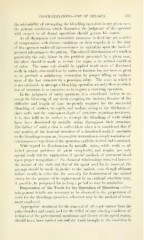Page 545 - My FlipBook
P. 545
TOOTH-BLEACHING— USE OF CHLORIX. 543
the advisability of attompting the bleaching operation in any given case,
the general conditions which determine the jndgnient of the operator
with respect to all dental operations should govern his course.
As all therapeutic and restorative measures in dentistry are a series
is the duty
of compromises Avith disease conditions or their scquela% it
of the operator under all circumstances to capitulate upon the basis of
greatest advantage to the patient. Therefore if discoloration of a tooth is
practically the only factor in the problem presented by a given case,
the effort should be made to restore the organ to its normal condition
of color. The same rule should be applied to all cases of discolored
teeth in which structural loss by caries or fracture has not been so great
as to preclude a satisfactory restoration by proper filling or replace-
ment of the lost structure by a porcelain inlay. The cases in which it
is not advisable to attempt a bleaching operation are only those in which
loss of structure is so extensive as to require a crowning operation.
In the judgment of many operators it is considered useless to at-
tempt the bleaching of any teeth excepting the incisors, because of the
difficulty and length of time frequently required for the successful
bleaching of canines, bicuspids, and molars, owing to the thickness of
their walls and the consequent depth of structure requiring treatment.
It is also held to be useless to attempt the bleaching of teeth which
have been discolored by metallic stains throughout their structure.
The fallacv of such a view is self-evident when it is considered that if
any portion of the dentinal structure of a discolored tooth is amenable
to the bleaching treatment, its complete restoration is simply a question of
continuance or repetition of the operation until the desired end is attained.
With regard to discoloration by metallic stains, while teeth so af-
fected present problems of great complexity, and require not only
special study but the application of special methods of treatment based
upon proper recognition of the chemical relationships involved between
the nature of the stain and that of the agent used for its removal, the
attempt should be made in justice to the patient, even though idtimate
failure result, in order that the necessity for destruction of the natural
crown for the purpose of its replacement by an artificial substitute may,
if possible, be postponed for as long a ]ieriod as may be attainable.
Preparation of the Tooth for the Operation of Bleaching.—Cer-
tain general details are necessary to be observed in tlu^ jn-eparation of
teeth for the bleaching operation, whatever may be the method of treat-
ment employed.
Appropriate treatment for the removal of all se])tic matter from the
pulp chamber and canal, and for the relief of any existing condition of
irritation of the pericemental membrane and tissues of the apical region,
should have been carried out and the tooth brought to the condition in


